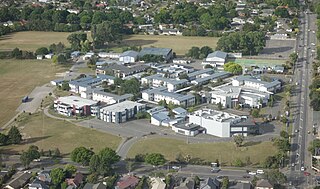
Ashburton is a large town in the Canterbury Region, on the east coast of the South Island of New Zealand. The town is the seat of the Ashburton District. It is 85 kilometres (53 mi) south west of Christchurch and is sometimes regarded as a satellite town of Christchurch.

Lincoln is a town in the Selwyn District, in the Canterbury Region of New Zealand's South Island. The town is located on the Canterbury Plains to the west of Banks Peninsula, 22 kilometres southwest of Christchurch. The town has a population of 8,130, making it the second largest town in the Selwyn District behind nearby Rolleston.

Van Asch Deaf Education Centre was located in Truro Street, Sumner, Christchurch, New Zealand. It was a special school for deaf children, accepting both day and residential pupils, as well being as a resource centre providing services and support for parents, mainstream students and their teachers in the South Island and the Lower North Island.

Cashmere High School is a state coeducational secondary school, located in southern Christchurch, New Zealand. It was opened in 1956 in response to population growth in southern Christchurch during the 1950s.

Rolleston is the seat and largest town in the Selwyn District, in the Canterbury region of New Zealand's South Island. It is located on the Canterbury Plains 22 kilometres (14 mi) south-west of Christchurch, and is considered a satellite town of the city. The town has a population of 21,900, making it New Zealand's 26th largest urban area. It was nicknamed the "Town of the Future" in the 1970s by Prime Minister Norman Kirk. The "Town of the Future" signage has since been removed from the entrances to Rolleston.

Burnside High School is a state co-educational secondary school located in the suburb of Burnside in Christchurch, New Zealand. With a roll of 2481 students, it is the largest school in New Zealand outside Auckland, and is among the country's four largest schools.

Queen Elizabeth II Park was a multi-use stadium in Christchurch, New Zealand, located in a large park of the same name. The stadium had a capacity of 25,000 people and was built in 1973 to host the 1974 British Commonwealth Games, with a temporary 10,000 seat western stand erected for that event to take the capacity to 35,000. The stadium suffered some damage in the September 2010 Canterbury earthquake but was able to reopen, only to be damaged beyond repair in February 2011 Christchurch earthquake.

Ao Tawhiti or Ao Tawhiti Unlimited Discovery is a state area school in Christchurch, New Zealand. It was established by the merging of two separate Christchurch inner city schools; the primary school Discovery and the secondary school Unlimited Paenga Tawhiti.
Aranui High School was a large secondary school for years 9–13, in Christchurch, New Zealand. Aranui high school took its name from the suburb of Aranui, meaning 'big pathway' in Māori. Aranui High School was a coeducational alternative to other secondary schools in Eastern Christchurch such as Linwood College and Mairehau High School.
The provision of State Education in New Zealand developed from ideas about democratic and progressive education in the late nineteenth century. The creation of an education system that aimed to reduce inequalities and enable social mobility was an important goal for New Zealand's early educational reformists.

Shirley Boys' High School is a single sex state (public) secondary school in Christchurch, New Zealand. It was originally situated on a 6 hectare site in the suburb of Shirley, but in April 2019 moved, along with Avonside Girls' High School, further east to the former QEII Park, 8.6 kilometres from the city centre.
Chisnallwood Intermediate is the main Intermediate school in the eastern suburbs of Christchurch, New Zealand. The school had a student roll of 833 students in 2008, which had shrunk to 631 by 2016. The school was recommended for closure or merger in the 2013 Christchurch school review commissioned by Education Minister Hekia Parata, but was spared.

Patricia Hekia Parata is a former New Zealand politician and former member of the New Zealand House of Representatives, having been elected to parliament in the 2008 general election as a member of the New Zealand National Party. She served as the Minister of Education in the Fifth National Government.

Avonhead is a suburb of the New Zealand city of Christchurch. It has two primary schools, a shopping centre and several parks.

Avonside Girls' High School is a large urban high school in Christchurch, New Zealand, with more than 1,000 girls from Year 9 to Year 13. It was formerly in the suburb of Avonside but moved in 2019, along with Shirley Boys' High School, to the former QEII Park site in the east of Christchurch.

A major earthquake occurred in Christchurch, New Zealand, on Tuesday 22 February 2011 at 12:51 p.m. local time. The 6.2 earthquake struck the Canterbury region in the South Island, centred 6.7 kilometres (4.2 mi) south-east of the centre of Christchurch, the country's second-most populous city. It caused widespread damage across Christchurch, killing 185 people, in the nation's fifth-deadliest disaster.
Charter schools in New Zealand, also known as partnership schools or kura hourua, were schools that received government funding similar to state schools but were subject to fewer rules and regulations from the Ministry of Education. They are free and open for any students to attend. Charter schools had the autonomy to set their own curriculum, qualifications, pay rates for teachers, school-hours and school terms. The schools were operated by sponsors such as Māori Iwi, not-for-profit organisations, businesses or existing education providers.














